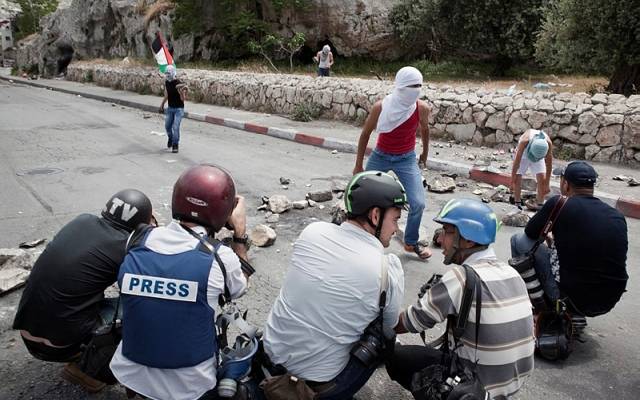Coverage of the latest round of violence in Gaza failed to take into account the months-long, Hamas-led attacks by Palestinian rioters, unfairly putting the onus on Israel, media watchdogs charge.
By: Jackson Richman/JNS
Coverage of the Israeli-Palestinian conflict has long been a sore spot for Israel and its supporters. For years, the pro-Israel community has accused the media of bias in their reporting, especially during times of near-war skirmishes.
The most recent clashes in Gaza were no exception, with some media watchdog groups claiming that coverage of the flare-up, which saw more than 450 rockets fired towards Israel in less than 48 hours, failed to take into account the months-long attacks by Palestinian rioters, prompted by Hamas, upon southern Israel leading up to the rocket attacks.
“Journalists never cover the Gaza situation fairly. Never,” Dan Gainor, vice president of business and culture at the Media Research Center, a media watchdog group, told JNS.
“Hamas has been trying to tear down the border fence, has sent terrorists across the border, and has launched rockets and fire kites into Israel, but the media have almost completely ignored every attack,” he said.
“They won’t call them ‘terrorists,’ even though the US considers Hamas a terror organization, and they claim ‘dozens’ of rockets,” said Gainor. “There have been hundreds and hundreds. That’s not journalism. It’s public relations.”
An example of such bias occurred at a State Department briefing last week when a reporter asked department spokesperson Heather Nauert, “Do you condemn the Israeli action?”
Media Bias in Previous Gaza Conflict
In many ways, the reporting in the recent conflict in Gaza draws parallels to the last large-scale violence in 2014 as part of “Operation Protective Edge,” when there was a disproportionate focus on actions by Israel that led to civilian deaths, but not on violent actions undertaken by Hamas, a Palestinian terror group long accused of using civilians as human shields.
For example, during the 2014 conflict, BBC reporter Emily Maitlis asked Mark Regev, the Israeli prime minister’s spokesperson at the time, about Israel bombing a Gaza school. She assumed that Israel was nothing but guilty even though the Israeli army had forewarned those inside the building to leave—men, women and children who were being used by Hamas as human shields.
“The UN told us that it tried to coordinate a window with the Israeli army for civilians to leave, and that was never granted,” said Maitlis. “Now, either the Israeli army is not speaking to the government or else you’re calling [Prime Minister Benjamin Netanyahu] a liar. Which is it?”
Another example of such previous bias is the publication of headlines equating attackers with victims.
“The media must also account for itself and for its own conduct, including apparent omissions and failures in the reporting of the conflict,” said former BBC correspondent Richard Miron. “It must question where reporting may have ended and emoting began, if it held Israel to a standard apart from all others and why it allowed Hamas a free pass in controlling the flow of information.”
“Its coverage had consequences in fueling the passions [and hatred] of many on the streets of Paris, London and elsewhere towards Israel, and by extension towards Jews,” he added.
‘Putting the Onus on Israel’
Another is the following Washington Post headline on Nov. 12 that reads: “Botched Israeli operation sparks surge of violence.”
It “puts the onus for the violence on Israel,” according to Sean Durns of the Committee for Accuracy in Middle East Reporting in America (CAMERA), which monitors anti-Israel media bias.
“Readers are left with little clue that Hamas has been perpetrating anti-Jewish violence, including mass arson, for months,” Durns told JNS. “They’ve been attacking Israeli civilians while using Palestinian civilians as human shields—a double war crime that is too often obfuscated on or omitted by the press.”
“Indeed, the paper even says that in recent months on the Israel-Gaza border ‘more than 200 Palestinians have been killed … mostly by Israeli sniper fire,’ but neglects to mention that Hamas itself has admitted that many of those killed were terrorists,” he added. “By failing to fully document the months of Hamas-sponsored attempted bombings, arson and rocket attacks that preceded the recent violence, the press is omitting essential context.”
Sarah Stern, the founder and president of the Endowment for Middle East Truth (EMET), noted the double standard the media displays in covering the conflict.
“I am again astounded about the media silence,” she told JNS. “Over 400 missiles flew in from Gaza over the last 24 hours, and there is hardly a mention about this in the media. Residents of Sderot and the other communities neighboring Gaza have a mere 15 seconds to run for shelter.
“Could you imagine what it must be like to have to endure over 400 incoming missiles in 24 hours? And could you imagine the media outcry if the missiles were coming in the other direction,” she added. “The silence is absolutely deafening, as it speaks volumes about the moral myopia of the media.”
Frank Sesno, a former CNN Washington bureau chief and currently the director of George Washington University’s School of Media and Public Affairs, summarized to JNS what he believes is behind the media bias regarding the conflict.
“The coverage of Israel-Hamas reflects several things: a lack of understanding of the issues and players, pervasive fatigue with a conflict that does not resolve and a pervasive sense among many that Israel plays Goliath—the giant power that dominates and oppresses,” he explained. “To some extent, that’s true, but too often history and nuance are forgotten.”
